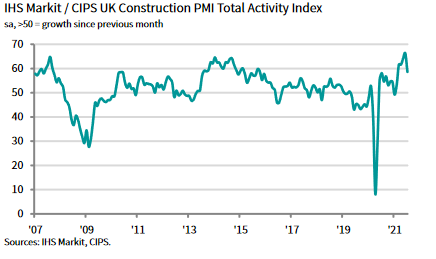Construction output loses momentum as subcontractor availability hampers progress
Recovery in UK construction output lost its momentum since June as the sector struggled to keep pace with the recent surge in demand for construction
projects, especially due to raw material supply shortages and shrinking sub-contractor availability.

Latest results for the IHS Markit/CIPS UK Construction PMI Total Activity Index registered 58.7 in July – down sharply from June’s 24-year high of 66.3 but still well above the crucial 50.0 no-change threshold. The latest reading signalled the slowest overall increase in construction output since February.
With demand for construction materials continuing to outstrip supply, latest data signalled another steep increase in purchasing prices. Around 81% of the survey panel reported a rise in their average cost burdens during July, while only 1% signalled a decline.
House building was the best-performing category in July (index at 60.3), followed closely by commercial building (59.2). In both cases, the rate of expansion was the weakest since February. This mostly reflected stretched business capacity and growth constraints due to supply issues, but some firms noted that the post-lockdown spike in customer demand had started to wane.
Civil engineering activity (55.0) followed the momentum seen elsewhere in the construction sector during July, with growth easing sharply since June and the lowest for five months.
Total order books continued to improve in July, but the latest rise in new work was the weakest since March. Similarly, input buying expanded at the slowest pace since April amid a softer recovery in demand. Construction companies also noted that reduced materials availability had acted as a brake on purchasing volumes in July.
Around 66% of the survey panel reported longer wait times for supplier deliveries in July, while only 2% signalled an improvement in vendor performance. The resulting index signalled widespread supply chain delays, although the latest reading was up from June’s record low and the highest for three months. Survey respondents noted that supply imbalances were amplified by a lack of transport availability, port congestion, and Brexit trade frictions.
A rapid pace of input cost inflation continued in July, fuelled by supply shortages and robust demand for construction items. Higher charges among sub-contractors and difficulties filling staff vacancies also added to price pressures. The latest decline in sub-contractor availability was the second-fastest since the survey began in 1997, exceeded only by that seen during the lockdown in April 2020.
Finally, construction firms continued to hire staff at a strong pace, reflecting rising orders and confidence regarding the near-term outlook. While optimism toward future output growth remained historically high, the index drifted down to its lowest for six months in July.
Tim Moore, economics director at IHS Markit, said: “Long lead times for materials and shrinking subcontractor availability were cited as factors holding back work on site.
“Around two-thirds of the survey panel experienced longer wait times for supplier deliveries in July, while just 2% reported an improvement since the previous month.
“July data marked the first real slowdown in the construction recovery since the lockdown at the start of this year. It was unsurprising that UK construction companies were unable to maintain output growth at the 24-year high seen in June, especially with widespread supply shortages and constrained capacity to take on additional orders.”
Duncan Brock, group director at the Chartered Institute of Procurement & Supply, added: “The pervasive weaknesses in supply chains along with a lack of staff and contractor availability were laid bare as construction lost some of its get-up-and-go.
“The rampant rise in prices for raw materials and transportation continued to be the construction’s heavy load along with historically long delivery times.
“Though there was a slight improvement in supplier performance from June’s record low, it was partly as a result of frustrated supply chain managers reining back on purchases that were unlikely to arrive when needed.
“Businesses were also unable to expand on staff capacity, where even the most prolific hiring periods since 2014 was insufficient for builders’ ability to complete work in hand.
“Faced with transport disruptions, shortages of essentials and Brexit delays, the initial spurt of activity this year is fast hitting the rocks.
“Building optimism was dampened to the lowest since January as it is difficult to foresee when all these challenges are likely to subside.”
Sector reaction
Mark Robinson, group chief executive at SCAPE
“With the combined effect of the full reopening of the economy and the sector’s usual summer boom, it’s no surprise to see a trajectory of continued growth for the construction industry. However, whether this trend continues in the face of ongoing materials and labour shortages remains to be seen, as building in many major UK cities is now more expensive than in Paris, Berlin or Singapore.
“Collaboration is going to be crucial if we are to overcome the hurdles created by rising costs. Clients need to bring contractors on board earlier in the process to ensure that they’re on the same page about what’s possible for their project, and contractors have a responsibility to work closely with their supply chain, to mitigate the risk of shortages and price increases. These steps will help reduce any negative impacts on projects and retain much-needed delivery momentum.”
Gareth Belsham, director of the national property consultancy and surveyors Naismiths
“This is the clearest evidence yet that the construction industry’s supply chain problems are more than mere speed bumps.
“Increasing numbers of construction firms are admitting to clients that they simply cannot keep up with demand for building projects.
“The cost of, and wait time for, building materials continues to mushroom amid a perfect storm of surging demand, factories dogged by staff shortages, rising fuel costs, congested ports and post-Brexit trade friction.
“These problems aren’t just slicing into contractors’ margins, they’re now constraining output too. While overall construction industry growth remains strong, especially in the red-hot housebuilding sector, the rate of expansion has cooled sharply.
“Total output is now back down to the levels seen in February, during the depths of the UK’s last lockdown.
“As a result business confidence has also taken a knock, slipping to a six-month low.
“Cool heads in the industry have seen this all before, and pragmatic builders and their clients are recalibrating prices and schedules and getting on with it.
“But there is still the nagging question about the current runaway material cost inflation; is it a short-term blip or are we facing a long-haul of rising prices? The jury is still out on that one.”
Fraser Johns, finance director at construction firm Beard
“It’s clear that the current challenges facing the construction industry are now undermining the post-pandemic recovery we’d seen during the first half of the year.
“Supply chain delays, materials shortages, price rises, logistical problems, skills shortages and even the ‘pingdemic’ all conspired in July, resulting in the slowest rate of output since February.
“We know these are challenges that are not set to go away any time soon, so in order to move forward it’s going to be crucial to take a proactive approach.
“Working in collaboration with suppliers and subcontractors, including ensuring prompt payment, will go some way to mitigate the risk of projects falling through.
“But customers need to be aware of the issues facing the industry is facing as well. Being transparent at the point of submitting tenders about the need to order certain materials early to ensure delivery on time, using two stage procurement processes, will help to overcome some of these issues.”















